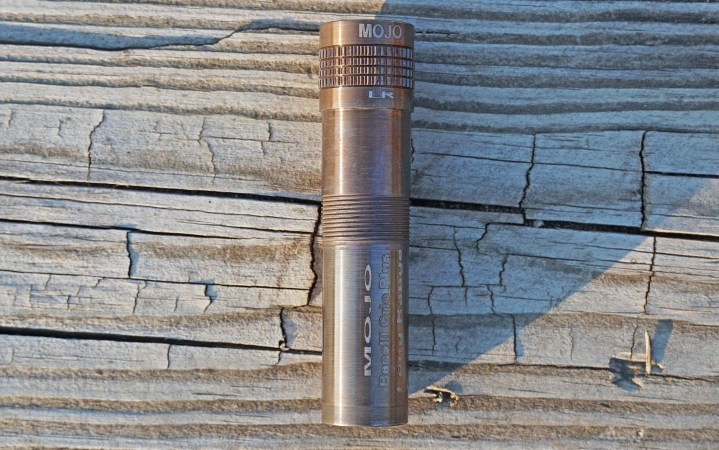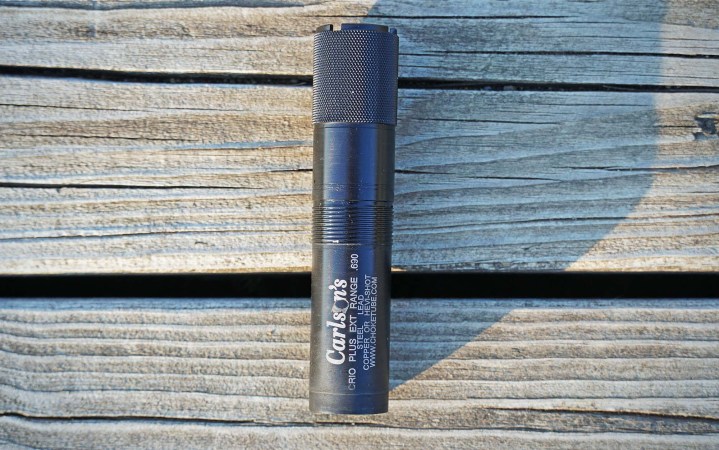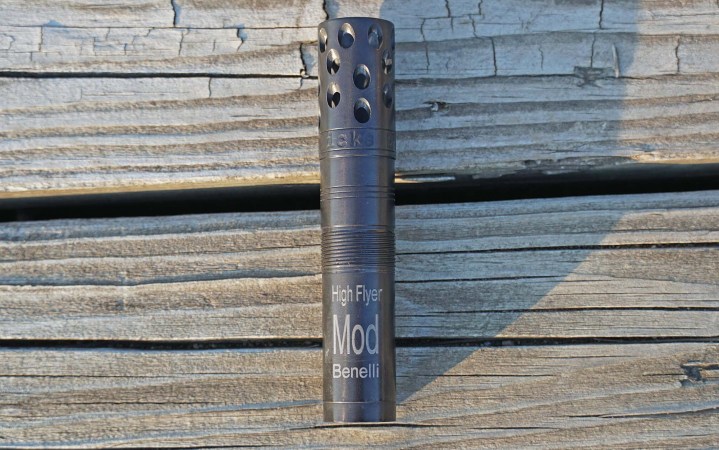We may earn revenue from the products available on this page and participate in affiliate programs. Learn More ›
It can feel like there’s a certain amount of voodoo involved in picking the best choke for duck hunting. This is because there are so many variables at work. Starting with the gear, there’s your gun and favorite duck load. Different chokes will perform differently as you switch up these combinations.
Then there’s the species you intend to hunt and the distance at which you most commonly shoot. For example you’d want a different choke for long crossing shots at diver ducks than you would for decoying teal. Then there’s the most critical factor of all: your shooting ability.
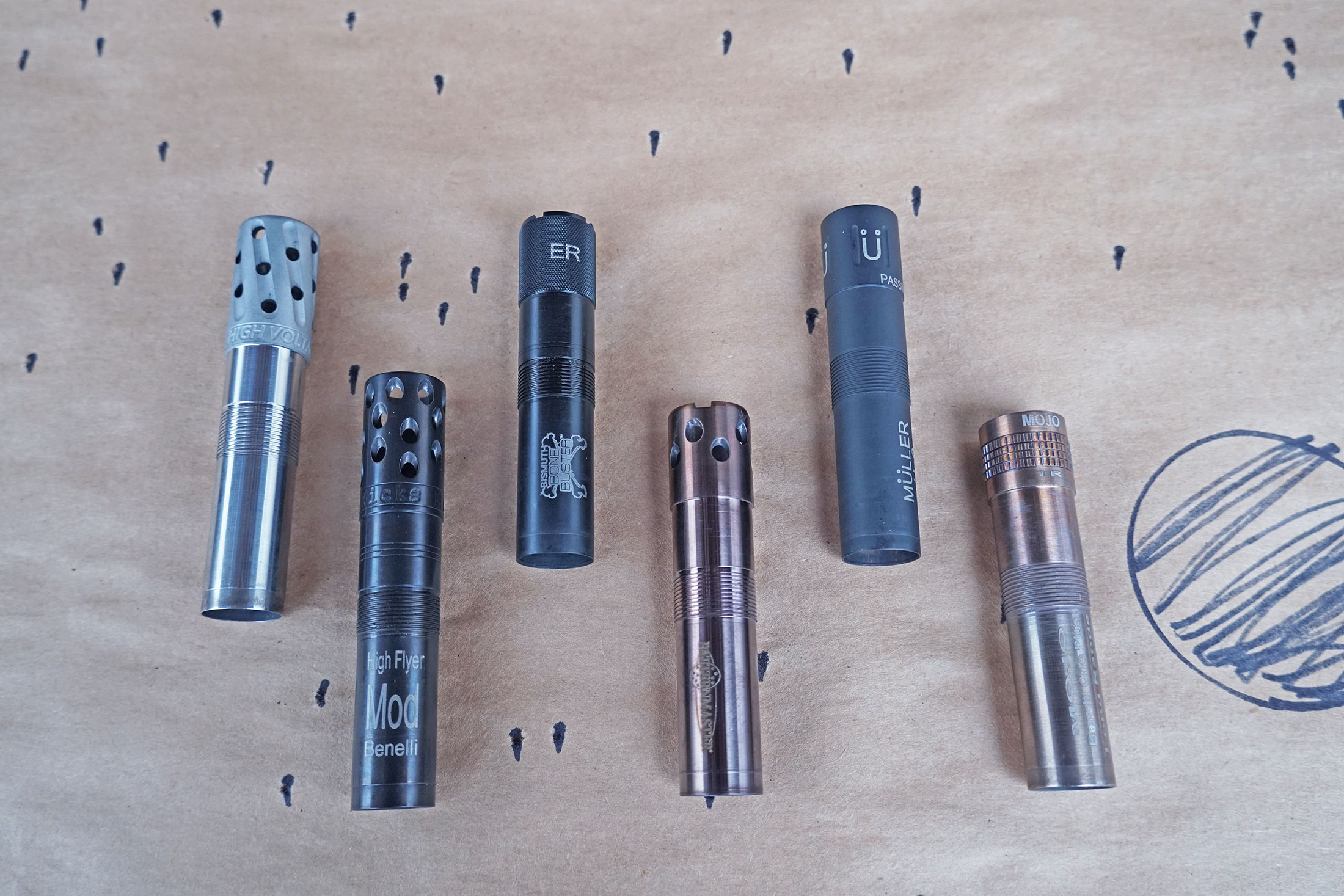
Photo by Alex Robinson
If you are the pragmatic type and want a shortcut to lethal patterns, then simply screw in the stock Modified choke tube that came with your duck gun. Buy a couple different boxes of steel No. 2 duck loads. You’ll want a variety of velocities, and, assuming that your gun is a 12-gauge, payloads of 1 ¼ ounces and 1 3/8 to experiment with. Pattern these loads at the distance you plan to shoot ducks and then pick the load that performs best out of your gun. (Hint: it’s the one that consistently puts a dense and even spread of pellets inside a 30-inch circle.) Keep all your hunting shots inside 40 yards and never worry about chokes or loads or pellet counts ever again.
But maybe you’re the type of duck hunter who doesn’t want to settle for basic performance. In that case, you’ll probably need an aftermarket choke tube. You’ll also need to embrace the voodoo, and read on.
- Best Overall: Mojo Fatal Shot
- Densest Pattern: Jebs High Voltage
- Most Consistent: Muller H20
- Patternmaster Code Black
- Carlson Bismuth Bone Crusher
- Kicks High Flyer
| Choke | Kent Av. Pattern Density | Rem. Av. Pattern Density |
| Mojo Fatal Shot | 119 | 121 |
| Jebs High Voltage | 126 | 116 |
| Muller H20 | 104 | 117 |
| Patternmaster Code Black | 111 | 101 |
| Kick’s High Flyer | 94 | 94 |
| Stock Modified | 95 | 108 |
| Bismuth Choke/Loads | Rem Bismuth Av. Pattern Density | Fed. Bismuth Av. Pattern Density |
| Carlson’s Bone Buster | 88 | 86 |
| Stock Modified | 82 | 81 |
How I Tested the Best Chokes for Duck Hunting

Photo by Alex Robinson
While I would have liked to test all the chokes in this review with all the major duck guns, loads, gauges, and shot sizes at a variety of different distances, that would have required a Doctor Strange-like ability to live in several multi-verses at once. So instead of running 14,000,605 scenarios, I narrowed it down to some very standard options detailed below.
- Gun: I tested all chokes in my 12 Gauge Benelli SBE 3
- Steel Loads: For the general chokes in this review I tested with Kent Fasteel No. 2, 1 ⅜ ounces at 1300 fps and Remington Nitro Steel No. 2, 1 ¼ ounces at 1450 fps.
- Bismuth Loads: For the bismuth-specific choke I shot Remington Premier Bismuth No. 2, 1 ⅜ ounces at 1400 fps and Federal Hevi-Bismuth No. 3 1 ⅜ ounces at 1450 fps.
- Distance: I shot all patterns at 40 yards, as this is the industry standard and realistically the maximum range for consistent lethal shooting for most duck hunters.
- Patterning Procedure: I shot six patterns with each choke, shooting the two loads per choke three times. For each pattern, I counted the number of pellet strikes within a 30-inch circle that covered the heart of the pattern. I then averaged the number of pellet strikes with each choke/load combination.
- Chokes Tested: Stock modified (as a control), Mojo Fatal Shot, Jebs High Voltage, Muller H20, Patternmaster Code Black, Carlson Bismuth Bone Buster, Kicks High Flyer
- Conditions: I shot on a mild, 40-degree day with a light headwind.
The pattern data I gathered is unique to my gun and the loads I chose to test. It’s possible, even likely, that these aftermarket duck chokes would have different pattern performance with different guns and loads. So use my results as reference and a baseline for your own patterning.
Understanding Shotshell Lethality

Photo by Alex Robinson
Three things are required to kill ducks: pellet density, pattern density, and velocity.
Assuming you’re shooting at reasonable ranges with standard ammo, velocity is the least important factor (the pellets will be moving plenty fast enough to penetrate).
Pellet density comes from your shot material selection (steel, bismuth, or tungsten). All things being equal, denser material penetrates better. However the denser materials like bismuth and tungsten are also a lot more expensive, so many duck hunters stick with steel loads.
And this is where pattern density and choke selection comes into play. For clean kills, we want as many pellets as possible on target. So why not shoot a life-sized duck-shaped target when patterning?
Shotgun shooting is a fluid act and each pattern—even fired from the same gun/choke/load combo—is as an individual snowflake. So the number of pellets that would hit that duck-shaped target would be somewhat random. Instead we evaluate patterns using a much larger 30-inch-diameter circle. The more pellets we can place inside that circle—in other words the denser our pattern—the higher the likelihood of hitting a bird in the vitals.
Establishing a Baseline
How many pellets is enough? Tom Roster has done an incredible amount of lethality testing on live birds with a wide variety of steel loads. Based on that research, he says that about 90 No. 2 steel pellets within a 30-inch circle are required to reliably kill large ducks. More, of course, is better.
By choosing a tighter choke tube, we’re able to shoot a denser pattern, at least theoretically. Go too tight and you risk blowing out the pattern. This happens most commonly when you use large shot sizes (like BB) with Full chokes. The payload becomes too constricted while trying to leave the muzzle, and instead of hanging together in a dense pattern, the pellets scatter widely. Running a full choke with large steel pellets can also damage your barrel.
Selecting a choke that is too tight can also create a pattern that is too tight for close and moderate ranges. Yes, we want to see a nice dense pattern at 40 yards, but we also want to see an equally effective pattern at 30 and 20 yards. Go too tight and you’ll be throwing a softball-sized pattern at close range.
Beyond simple pattern density, you want to see the pellet strikes spread evenly throughout the core of the pattern and then gradually decrease as you move toward the edges. You do not want to see big gaps in the pattern.
As a control for this test, I shot all the loads through my stock Modified choke and recorded the averages below.
Stock Modified Choke Average Pellet Strikes in 30-inch Circle
- Kent Steel Load: 95
- Remington Steel Load: 108
- Federal Bismuth Load: 82
- Remington Bismut Load: 81

With these pattern densities, I consider my max range to be 40 yards. So would using aftermarket duck hunting chokes improve my pattern at 40 yards, and even 50 yards? In a word, yes. One side note: When evaluating the patterns in the photos below, don’t worry about if they’re perfectly on target. The goal is not to score my shooting ability (thankfully). The goal is to judge how dense and even of a pattern each choke/load combination is able to produce.
The Best Chokes for Duck Hunting
Best Overall: Mojo Fatal Shot
Average Pellet Strikes in 30-inch Circle
- Kent Load: 119
- Remington Load: 121
Key Features
- Available in Short, Medium, and Long Range (tested) options
- Non-ported
- Made in the USA
- Price: $80
Pros
- Printed dense patterns with both loads
- Relatively affordable
Cons
- I didn’t love the bronze color
The Mojo tube and the Jebs tube (see below) essentially had the same patterning scores. With both steel loads, these two chokes printed much denser patterns than my stock modified choke—and also the rest of the tubes in the test.
However the Mojo Fatal Shot gets the win as the overall best choke for duck hunting because it shot more even patterns than the Jebs. As you can see in the photo below, the core of the pattern has an even smattering of strikes and there are no gaping holes. As you move out from the core, you see decreasing strikes with some smaller holes around the edges. Not quite perfect, but pretty damn close.

Photo by Alex Robinson
This should not be surprising as Mojo partnered with Rob Roberts, a custom gunsmith and Benelli shotgun whisperer, to create this tube. Mojo promises custom tube performance at an off-the-shelf price, and as far as I’m concerned, they delivered. The only ding is that the bronze color of the tube is not quite my style. But with this kind of performance I’ll learn to like it.
Mojo offers short-range, medium-range, and long-range constrictions. I’d recommend the long-range version (which is what I tested) unless you are committed to shooting decoying birds only.
Densest Pattern: Jebs High Voltage
Average Pellet Strikes in 30-inch Circle
- Kent Load: 126
- Remington Load: 116
Key Features
- Available in .685, .690 (tested), .695, and “short range” constrictions
- Ported or non-ported versions
- Matte silver finish
- Price: $100
Pros
- Printed single best pattern of the test
- Good variety of constriction options
Cons
- Clumped pellet strikes
The Jebs High Voltage tube printed the single densest pattern of the test, recording 134 pellet strikes with the Kent load. But looking beyond the numbers, the Jebs choke didn’t create the even, consistent patterns that duck hunters like to see—at least not compared to the Mojo choke. There were several instances of two- and three-pellet clusters striking right on top of each other, which is useful only if that little clump of pellets hits your target. The tradeoff is larger holes in the pattern that could lead to missed or wounded birds.

Photo by Alex Robinson
But still, the Jebs greatly outperformed my stock Modified choke as well as the other tubes in this review (expect the Mojo). I tested the .690 version, but it would be interesting to see if a slightly more open iteration (like the .695) would create less pellet clumping. Regardless, I would absolutely hunt with this choke using steel, bismuth, or TSS loads.
Most Consistent: Muller H20
Average Pellet Strikes in 30-inch Circle
- Kent Load: 104
- Remington Load: 117
Key Features
- Available in “decoying” “passing” (tested) and “UFO” constrictions
- Non-ported
- Matte black finish
- Price: $134
Pros
- Very consistent patterns
- Looks good
Cons
- Pricey
I didn’t think I’d ever describe the ubiquitous choke tube as “sexy,”—but then I met the Muller H20. This tube has a much more stylish design and build than the others in this test (some of which look like they were designed by that kid from highschool with the flame decals on his truck). When you screw the H20 into your gun, it feels custom made — and deadly. As well it should. Pro shooter Jimmy Muller has designed and built these tubes for ultimate consistency, and I saw that in my testing.

Photo by Alex Robinson
The patterns the Muller choke printed were wonderfully consistent, though not as dense as those shot from the Mojo and Jebs chokes. But still, the Muller choke put more pellets in the circle than my stock Modified choke with fewer gaps and holes. For hunters who are most concerned with consistency at moderate ranges, this would be the perfect choke. Then simply experiment with loads until you find one that prints the ideal patterns with your setup. I shot the “Passing” version for this review, but in future testing, I’d like to see how the tighter UFO version performs at 40 yards.
Patternmaster Code Black
Average Pellet Strikes in 30-inch Circle
- Kent Load: 111
- Remington Load: 101
Key Features
- Ported
- Non-reflective bronze finish
- Price: $90
Pros
- Wide variety of options
- Affordable
Cons
- Middling pattern performance
Patternmaster has an impressive selection of choke tube options and variations. For a few years I hunted with their Classic tube and had good success with it. But now there are so many newer options. In fact, I could spend an entire year testing only Patternmaster tubes if I wanted.
For this review I decided to go with the waterfowl model in their Code Black line. This line, like several others by Patternmaster, uses the company’s patented stud ring design. Patternmaster says the stud ring is designed to grab the base of the plastic wad of a load and hold it for a millisecond while the shot leaves the barrel. You’ve probably heard this design referred to as a wad-stripper choke.

Photo by Alex Robinson
The Code Black tube put up consistently solid patterns but couldn’t compete with the best of this test. I plan to test other Patternmaster tubes and update this story in the future.
Carlson Bismuth Bone Buster
Average Pellet Strikes in 30-inch Circle
- Remington Premier Bismuth Load: 86
- Federal Hevi-Bismuth Load: 88
Key Features
- Available in “Mid Range” and “Extended Range” (tested)
- Non-ported
- Lifetime warranty
- Price: $53 to $62
Pros
- Designed specifically for bismuth shot
- Affordable
Cons
- Sub-par pattern performance
Besides Patternmaster, no one has more choke options than Carlson’s. They make a choke for (essentially) every shotgun and every pursuit. With the resurgence in popularity of bismuth loads for waterfowl hunting, they offer a bismuth-specific choke (though you can shoot steel and lead through it if you like). According to Carlson’s, this choke has a longer parallel section through the middle of the choke which is optimized for patterning bismuth.

Photo by Alex Robinson
However, I didn’t see this play out in my pattern testing. Yes, the Carlson’s choke beat my stock Modified choke in pattern density, but just barely. Out of curiosity, I also shot the bismuth loads through the Muller choke tube and got superior patterns through it, putting more than 100 pellets within a 30-inch circle using Federal’s No. 3 load. Whatsmore, when I patterned Federal’s Hevi-Bismuth load last year I used my stock Full choke and was able to average 128 pellet strikes within a 30-inch circle. That’s far superior to the Bone Buster results. In general, steel patterns more tightly than bismuth. So if you are planning to shoot bismuth at ranges of 40 to 50 yards, I recommend starting pattern work with a stock full choke before throwing down for an aftermarket option.
Kick’s High Flyer
Average Pellet Strikes in 30-inch Circle
- Kent Load: 94
- Remington Load: 94
Key Features
- Available in Modified (tested) or Full versions
- Ported
- Price: $45 to $60
Pros
- Affordable
- Available for variety of guns and constrictions
Cons
- Sub-par pattern performance
This was the only choke in the test that didn’t outperform my stock Modified choke. That said, I tested the Modified version of the High Flyer, so I wouldn’t have expected the patterns to be significantly denser—though I’ll admit it was disappointing to see fewer pellet strikes. The Kick’s choke did print fairly even patterns with the Kent load, but not much better than my stock choke.
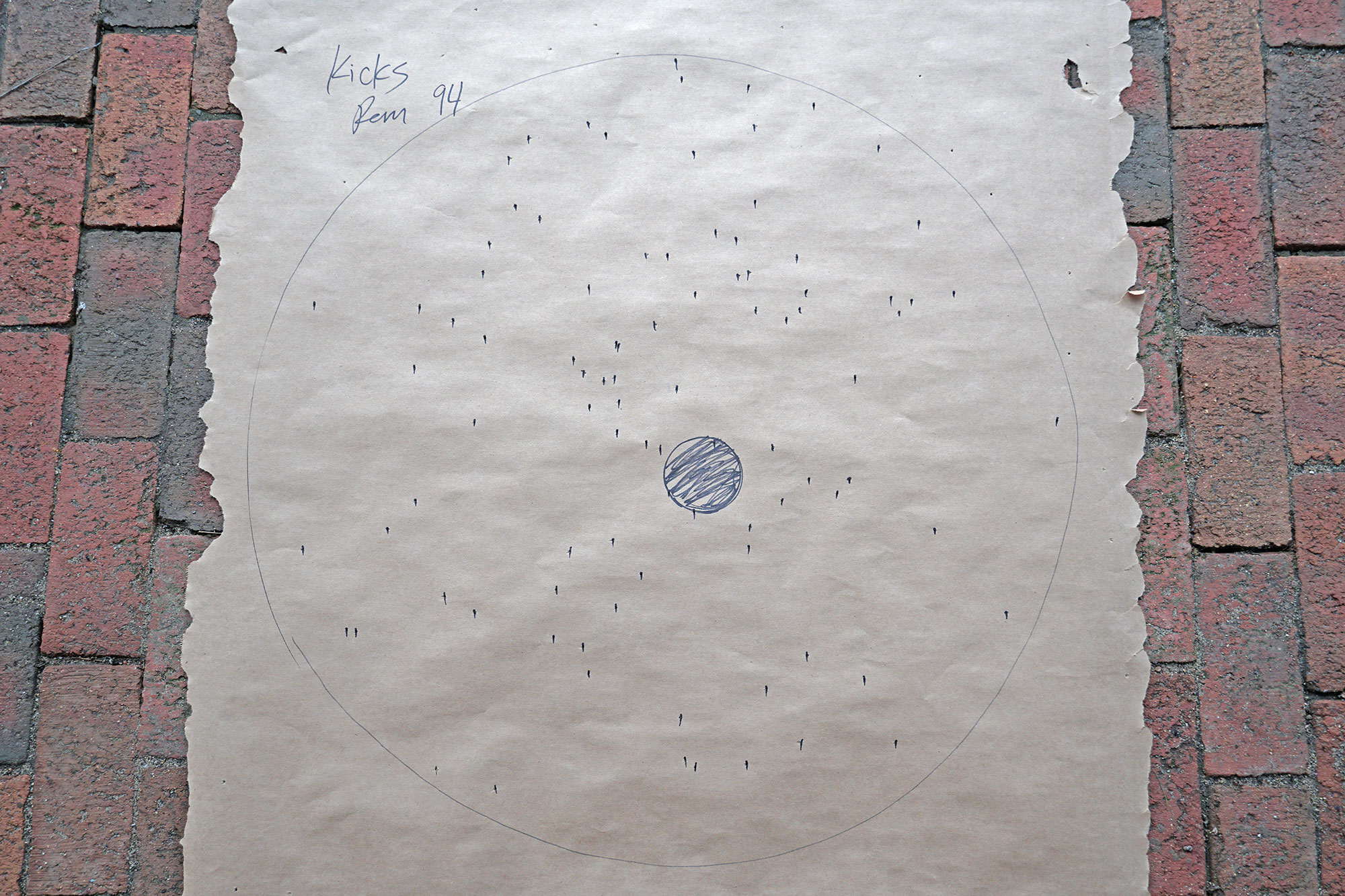
Photo by Alex Robinson
This choke combined with my test loads was right at the threshold for lethal kills at 40 yards. I would not shoot it beyond this range. I plan to test the Full version of this choke in the future and hopefully see better performance.
FAQs
At this point you’ve read an entire story on the best chokes for duck hunting without a single mention of pattern percentage, what gives? Putting emphasis on the percentage of pellets that end up on target is a bit silly if your main concern is killing ducks—even if nerdy forum posters obsess over percentages. What matters is the number of pellets striking within a 30-inch circle and how evenly those pellets are distributed. A higher pattern percentage doesn’t necessarily equate to more lethality. But if you must know, the 1 ¼ ounce steel test load holds approximately 156 pellets and the 1 ⅜ ounce steel test load holds approximately 172 pellets. The bismuth No. 3 test load held approximately 168 pellets. You’re welcome to do your own math. But it’s much more useful to evaluate the form of each pattern and its overall density.
Astute readers will notice that the Kent shells with heavier payloads didn’t outshoot the lighter, faster Remington loads in every instance. This is a bit surprising since the Kent loads bring about 16 more pellets to the party. And since they’re fired at a lower velocity they should produce more even patterns and fewer fliers, right? That proved to be true only about half the time. The Muller, Mojo, and stock Modified chokes actually all shot higher average patterns with the 1 ¼ ounce Remington load at 1450 fps. All I can say about that is: It’s why you’ve got to shoot ’em.
There are all sorts of tables out there on matching different shot sizes to different duck species at shot different ranges. Let’s keep it simple and forget all that. With steel ammo I recommend No. 2s. With bismuth ammo I recommend No. 3s. If you’re hunting small small ducks (like teal and woodies) early in the season you should go one shot size smaller in both materials (No. 3 steel and No. 4 bismuth).
A Modified choke is better for duck hunting. If you’re shooting bismuth, an Improved Modified choke is even better. Denser patterns and good shooting mean dead ducks not wounded ducks.
If you’re asking this question, keep it to about 30 yards and in. As you become a better shot and a more experienced waterfowler you can consider extending your range. To get an understanding of how far 30 yards is, use a rangefinder to
Final Thoughts on the Best Chokes for Duck Hunting

Photo by Alex Robinson
It’s true that the best chokes for duck hunting in this review will improve your patterns. And part of being an ethical duck hunter is to optimize your setup for lethality at reasonable ranges. “Reasonable” is the key term here. Forget all the bullshit you might see on social media and hunting forums about “crushing ’em at 80”. Absolutely none of the choke/load combinations in this review would reliably kill ducks at 80 yards. The goal is not to make a single hail Mary shot at 80, but rather to make every single shot at 40.
Read Next: The Best Duck Hunting Shotguns
And remember, there is no gun/choke/load combination that will make you a better shooter. There’s no magic to this part. It simply takes practice on the clays range and experience in the field. So if you had a duck season full of misses and lost birds, don’t buy a new choke. Buy yourself a membership at the nearest sporting clays course.
- Best Overall: Mojo Fatal Shot
- Densest Pattern: Jebs High Voltage
- Most Consistent: Muller H20
- Patternmaster Code Black
- Carlson Bismuth Bone Crusher
- Kicks High Flyer




